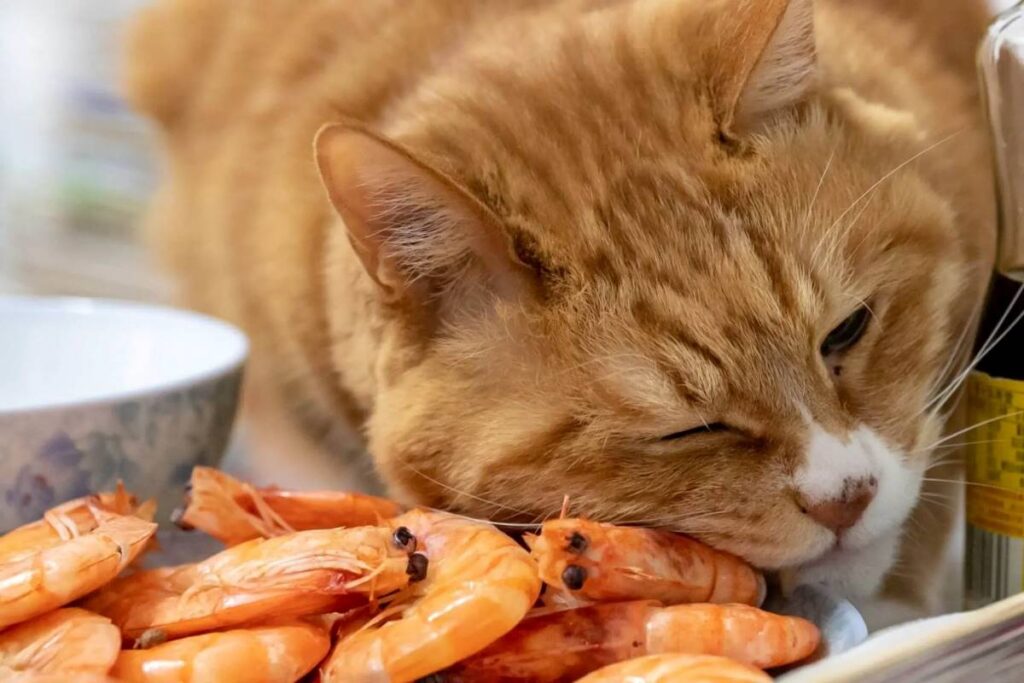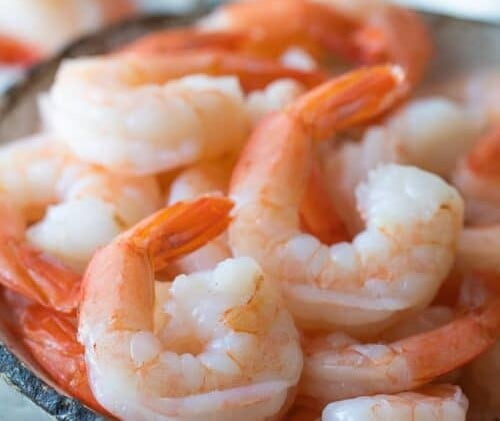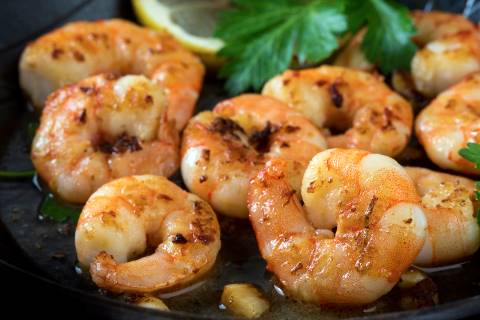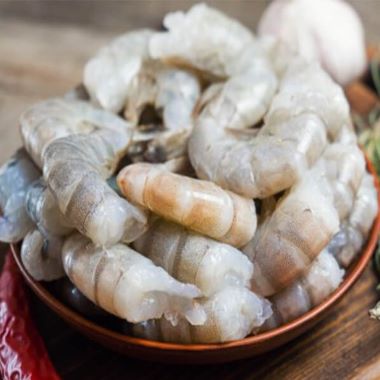How to Cook Prawns for Cats: A Guide

As responsible cat owners, we constantly seek ways to enrich their lives, whether through play, proper grooming, or, most importantly, their diet. While commercial cat food is designed to meet their nutritional needs, there’s a growing interest in adding wholesome, natural treats to their menu.
Enter prawns – a delectable seafood option that can be a delightful addition to your cat’s diet when prepared and served correctly.
In this article we will discuss how to cook prawns for cats, their nutritional benefits, and other considerations to be taking while feeding your cat prawns.
Nutritional Value of Prawns:
Prawns are a low-calorie, high-protein seafood option, making them an attractive choice for both humans and pets. They are rich in essential nutrients such as:
Protein: Prawns are an excellent source of high-quality protein, essential for muscle maintenance, growth, and overall body function. Prawns have 25g of protein per 100g, similar to chicken or beef.
Omega-3 Fatty Acids: These healthy fats play a crucial role in maintaining skin and coat health, reducing inflammation, and supporting heart health.
Vitamins and Minerals: Prawns contain important vitamins like B12 and B6, along with minerals like iodine, zinc, and selenium, which contribute to various physiological functions.
Astaxanthin: This antioxidant gives prawns their pink color and provides potential health benefits, such as supporting the immune system and protecting cells from oxidative damage. Astaxanthin has greater antioxidant activity than beta carotenes, vitamin C, vitamin E, and lutein.
Can Cats safely eat Prawns?
Yes, Cats can eat Prawns safely, and also gain various health benefits from doing so. However, it would be better to consider prawns as an occasional cat treat instead of a proper meal replacement. Prawns have a low calorie count, and may not provide enough energy for your cat, despite filling their bellies.
Prawns also have a high cholesterol amount, which is about 80%+ more than other types of seafood. Excessive cholesterol can cause problems (both in humans and cats), so prawns should be consumed in moderation.
There is also the fact that some cats may be allergic to prawns (or allergic to seafood in general). Be mindful of any medical issues regarding your cat while introducing them to something new, like prawns.
Identifying Safe Prawns for Cats:
When considering adding prawns to your cat’s diet, it’s vital to be discerning about the type of prawns you choose. Fresh, unseasoned, and cooked prawns are safe for feline consumption. However, it’s crucial to avoid prawns that have been seasoned, marinated, or treated with any additives. Cats are sensitive to certain flavorings and high levels of sodium, which can lead to digestive upset or adverse reactions.
Select prawns that are as natural as possible. Opt for those that haven’t been exposed to harmful chemicals or preservatives. It’s recommended to choose prawns that are fresh, rather than frozen, as freezing might affect their texture and nutritional content.
Preparing Prawns for Cats:
Proper preparation of prawns is paramount to ensure your cat’s safety and enjoyment. Follow these steps to prepare prawns suitable for feline consumption:
Choose Fresh Prawns: Select fresh prawns from a reliable source, ensuring they are free from additives or seasonings. Avoid prawns with a strong ammonia odor, as this indicates deterioration.
Cleaning the Prawns: Rinse the prawns thoroughly under cold water to remove any dirt, debris, or potential contaminants.
Removing Shells and Tails: Carefully peel off the shells and remove the tails. Cats might struggle with the texture of shells, and the tails can pose a choking hazard.
Removing Digestive Tract: Gently devein the prawns by making a shallow incision along the back and removing the dark vein-like digestive tract. This step is essential to avoid any potential gastrointestinal issues.
Your prawns are now ready for the next stage – being cooked!
How to cook Prawns for Cats: Methods and Considerations
Preparing prawns for your feline companion involves careful attention to cooking methods that preserve their nutritional value and ensure they are safe and palatable.

Boiled Prawns:
Boiling is one of the simplest, safest,and also the most recommended way to cook prawns for your cat. This method retains most of the prawns’ nutrients while eliminating potential pathogens. Here’s how to do it:
Ingredients:
- Fresh prawns
- Water (enough to cover the prawns)
Instructions:
- Start by thoroughly cleaning the prawns under cold water to remove any dirt or debris.
- In a pot, bring enough water to a boil to cover the prawns.
- Once the water is boiling, carefully add the prawns and let them cook for about 2-3 minutes or until they turn pink and opaque. You can turn off the heat a minute early, and let the prawns cook in the heated water (to prevent over cooking).
- Remove the prawns from the boiling water and let them cool completely before serving them to your cat.
- Optionally, you can cut the prawns into smaller, bite-sized pieces for easier consumption.

Deep-Fried Prawns:
As humans, we commonly eat Deep-Fried prawns, which leads us to wonder whether we can feed our cats the same thing. Before discussing the pros and cons of feeding cats deep-fried prawns, here is how you can prepare it:
Prepare the Prawns:
- Thoroughly clean the prawns under cold water to remove any dirt or debris.
- Remove the shells, tails, and digestive tracts, as these parts can be difficult for cats to digest.
- Select an appropriate cooking oil for deep frying, such as vegetable oil. Pour enough oil into a deep fryer or a heavy-bottomed pot, leaving sufficient space for the prawns to be submerged.
- Heat the oil to around 350°F (175°C).
Fry the Prawns:
- Gently place the prepared prawns into the hot oil. Be cautious to avoid splattering.
- Fry the prawns for about 2-3 minutes or until they turn golden brown and crispy.
- Use a slotted spoon to carefully remove the fried prawns from the oil and place them on a paper towel to drain excess oil.
- Allow the fried prawns to cool completely before serving them to your cat.
- You should consider cutting the prawns into smaller, bite-sized pieces for easier consumption.
While Deep-Fried prawns are commonly consumed by humans, it is not recommended to feed these to your cat. The calorie content for deep fried prawns is almost 3 times higher than regular boiled prawns. This is three times the calorie intake for the same nutritional value (or less because of the extra heat which breaks down nutrients).
Thus, while your cat can occasionally sample a deep fried prawn or two, it is not recommended as a regular part of their diet in any way.

Raw Prawns:
Most veterinarians advise against feeding raw meat to cats due to the risk of bacterial contamination. However, you may choose to incorporate small amounts of raw food into your cat’s diet. If you decide to offer raw prawns, take these precautions:
- Pick fresh prawns only. A good rule of thumb is to make sure that the prawns are fit for human consumption. If yes, then it’s also good enough for your cat.
- Make sure to properly clean the prawns using the guidelines given earlier in this article.
- Watch carefully for any sign of spoilage (e.g. foul odor, mold, blemishes in meat, etc).
FAQs
Can cats with kidney disease eat prawns?
A: Cats with kidney disease require a carefully managed diet to support their kidney function. Prawns, like any other high-protein food, can be problematic for cats with kidney disease due to the strain on their already compromised kidneys. These cats need a specialized diet that’s low in phosphorus and sodium.
Are Prawns good for overweight cats?
A: Prawns can be a suitable occasional treat for overweight cats, as they are low in calories and high in protein. This allows your cat to get the protein it needs, while keeping its calorie intake low. Prawns have less than half the number of calories when compared to other meats like chicken and beef. However, while prawns can be included in a cat’s daily diet, they should not constitute the predominant portion of their meals.
Conclusion
In this article we have discussed several techniques on how to cook prawns for cats, and their respective pros and cons. Out of all the methods we have discussed, boiling prawns is by far the safest and recommended way of adding prawns to your cat’s diet.
Remember, while prawns can certainly add a touch of delight to your cat’s culinary experiences, they should harmonize within the broader tapestry of a thoughtfully constructed feline diet.


